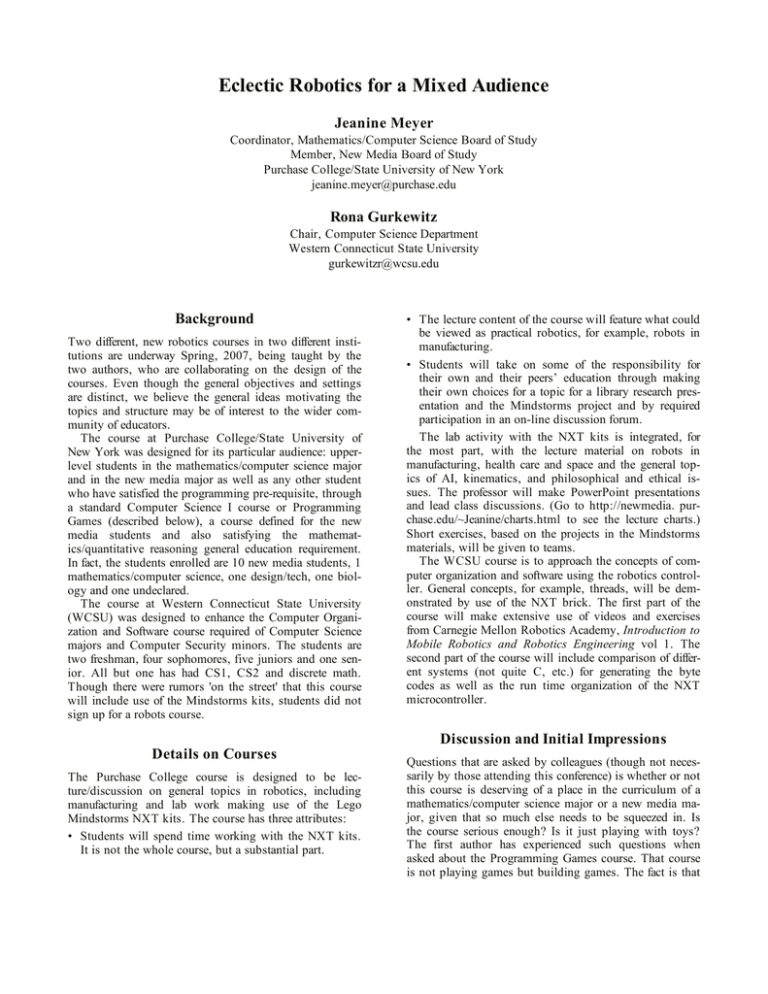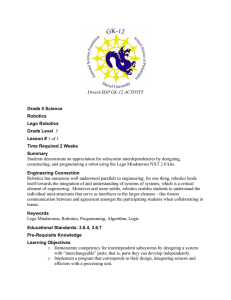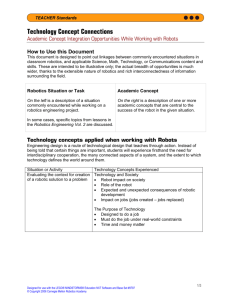Eclectic Robotics for a Mixed Audience Jeanine Meyer
advertisement

Eclectic Robotics for a Mixed Audience Jeanine Meyer Coordinator, Mathematics/Computer Science Board of Study Member, New Media Board of Study Purchase College/State University of New York jeanine.meyer@purchase.edu Rona Gurkewitz Chair, Computer Science Department Western Connecticut State University gurkewitzr@wcsu.edu Background Two different, new robotics courses in two different institutions are underway Spring, 2007, being taught by the two authors, who are collaborating on the design of the courses. Even though the general objectives and settings are distinct, we believe the general ideas motivating the topics and structure may be of interest to the wider community of educators. The course at Purchase College/State University of New York was designed for its particular audience: upperlevel students in the mathematics/computer science major and in the new media major as well as any other student who have satisfied the programming pre-requisite, through a standard Computer Science I course or Programming Games (described below), a course defined for the new media students and also satisfying the mathematics/quantitative reasoning general education requirement. In fact, the students enrolled are 10 new media students, 1 mathematics/computer science, one design/tech, one biology and one undeclared. The course at Western Connecticut State University (WCSU) was designed to enhance the Computer Organization and Software course required of Computer Science majors and Computer Security minors. The students are two freshman, four sophomores, five juniors and one senior. All but one has had CS1, CS2 and discrete math. Though there were rumors 'on the street' that this course will include use of the Mindstorms kits, students did not sign up for a robots course. Details on Courses The Purchase College course is designed to be lecture/discussion on general topics in robotics, including manufacturing and lab work making use of the Lego Mindstorms NXT kits. The course has three attributes: • Students will spend time working with the NXT kits. It is not the whole course, but a substantial part. • The lecture content of the course will feature what could be viewed as practical robotics, for example, robots in manufacturing. • Students will take on some of the responsibility for their own and their peers’ education through making their own choices for a topic for a library research presentation and the Mindstorms project and by required participation in an on-line discussion forum. The lab activity with the NXT kits is integrated, for the most part, with the lecture material on robots in manufacturing, health care and space and the general topics of AI, kinematics, and philosophical and ethical issues. The professor will make PowerPoint presentations and lead class discussions. (Go to http://newmedia. purchase.edu/~Jeanine/charts.html to see the lecture charts.) Short exercises, based on the projects in the Mindstorms materials, will be given to teams. The WCSU course is to approach the concepts of computer organization and software using the robotics controller. General concepts, for example, threads, will be demonstrated by use of the NXT brick. The first part of the course will make extensive use of videos and exercises from Carnegie Mellon Robotics Academy, Introduction to Mobile Robotics and Robotics Engineering vol 1. The second part of the course will include comparison of different systems (not quite C, etc.) for generating the byte codes as well as the run time organization of the NXT microcontroller. Discussion and Initial Impressions Questions that are asked by colleagues (though not necessarily by those attending this conference) is whether or not this course is deserving of a place in the curriculum of a mathematics/computer science major or a new media major, given that so much else needs to be squeezed in. Is the course serious enough? Is it just playing with toys? The first author has experienced such questions when asked about the Programming Games course. That course is not playing games but building games. The fact is that constructing computers games is challenging, more challenging than most students expect. The challenges come from the criticality of designing and preparing the humancomputer interface, representing the state of the game, and formulating the event handling. Similarly, building a robot, even following the directions in a kit and programming the robot to perform specific tasks requires considerable attention to detail and understanding of conditions such as real-world variability. Students must adopt disciplined ways of working with the equipment and define repeatable procedures for testing. Going beyond defined tasks to designing and then implementing their own projects requires creativity and programming skill. The performance of the robot projects are on view for all to see. The nature of robotics, the fun and the visibility, together with the unexpected difficulty, motivates and facilities deep learning. The robotics course is appropriate as a topic for the mathematics/computer science majors. After all, automation involving sensors and actuators is as significant in the modern world as [data] automation in banking. Similarly, many new media students have indicated a desire to build interactive art installations and doing the robotics projects should supply ideas and provide understanding of how sensors and actuators can work. Purchase College is a small institution and courses that serve multiple audiences have advantages. In this case, it is anticipated that students will come to the class with different capabilities. There will be programmers, builders, designers, planners, testers, and crew leaders. This is a good thing, not a bad thing. The students will benefit from working in teams and, hopefully, by trying something that they had not tackled previously. The robotics work can be presented to and appreciated by a wide audience. Though it is not our goal to participate in contests in the first offering, we may offer extra credit for attending and reporting on such events. This exhibitory nature of robotics provides opportunities to the mathematics/computer science majors generally reserved for the students in the Purchase arts conservatories. At WCSU, it was felt that the traditional Computer Organization and Software course needed an updating from the study of Microsoft Foundation Classes, assembler and low level programming to working with new hardware devices with low level software. Working with robots would serve the course in two ways. First, programming robots motors and sensors is low level programming, and the robot platform also supports multithreaded programming, event programming and communications programming with a widely used chip set. In the first day of the class at Purchase, students were enthusiastic. There was a demonstration of a robot following a line and another of the robot stopping when something was an inch away from the ultrasonic sensor, backing up, turning, and then going forward again. In class discussion and in an anonymous survey, students indicated that they looked forward to the discussions of manufacturing and other issues as well as the lab work. Several students indicated that they were nervous but also wanted to program the robots. The second class would be the day for building the basic Mindstorms robot. The first day at WCSU was spent looking at the Carnegie Mellon videos and doing the basic test bed exercises working in pairs. All the teams completed the tasks, though several needed minor help. One female student appeared to resist getting involved and let her female partner to the work. She later said that she was completely lost and worried about her grade point average and ended up dropping the course. This experience made the Purchase teacher decide to enforce a strict regime for the 3-perosn teams to rotate the work: finding parts, reviewing that they were correct, and adding the parts to the assembly. These are the plans for the course. At the conference in March, we will report on the reactions and achievements of the students in the first part of these pilot classes.




